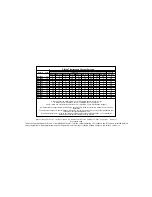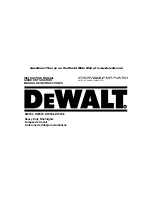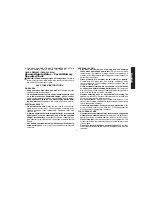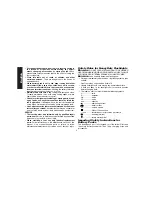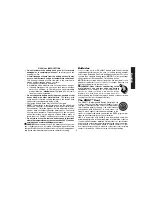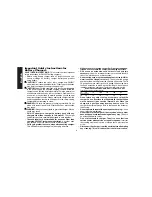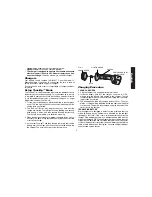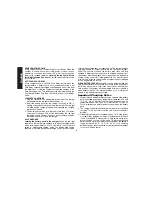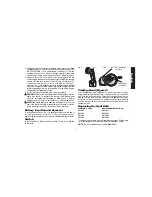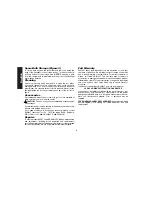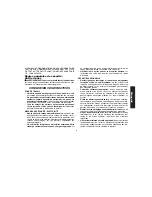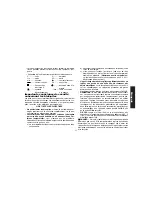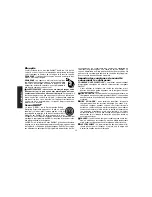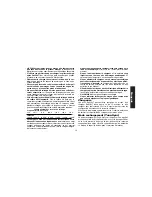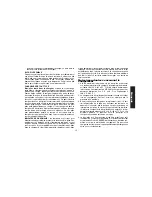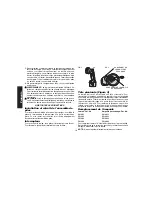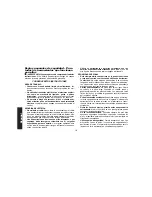
English
3
READ ALL INSTRUCTIONS
•
Do not incinerate the battery pack even if it is severely
damaged or is completely worn out.The battery pack can
explode in a fire.
•
A small leakage of liquid from the battery pack cells may
occur under extreme usage or temperature conditions.
This does not indicate a failure. However, if the outer seal is
broken and this leakage gets on your skin:
a. Wash quickly with soap and water.
b. Neutralize with a mild acid such as lemon juice or vinegar.
c. If battery liquid gets into your eyes, flush them with clean
water for a minimum of 10 minutes and seek immediate
medical attention. (Medical note: The liquid is 25-35% solu-
tion of potassium hydroxide.)
•
Do not carry extra battery packs in aprons, pockets, or tool
boxes along with other metal objects. The battery pack
could be short circuited causing damage to the battery pack
and possibly causing severe burns or fire.
•
Charge the battery packs only in D
E
WALT chargers.
•
NOTE: The batteries in your battery pack are the nickel–cad-
mium type. Cadmium is considered to be a toxic material by the
Environmental Protection Agency. Before disposing of dam-
aged or worn out Nickel–Cadmium battery packs, check with
your state Environmental Protection Agency to find out about
special restrictions on the disposal of these battery packs or
return them to a D
E
WALT certified service center for recycling.
•
Do not store or use the tool and battery pack in locations
where the temperature may reach or exceed 105°F (such as
outside sheds or metal buildings in summer).
DANGER: Never attempt to open the battery pack for any rea-
son. If battery pack case is cracked or damaged, do not insert into
charger. Electric shock or electrocution may result. Damaged bat-
tery packs should be returned to service center for recycling.
Batteries
Your tool uses an 18 Volt D
E
WALT battery pack. When ordering
replacement battery packs, be sure to include catalog number
and voltage: Extended Run-Time battery packs deliver 25% more
run-time than standard battery packs. NOTE: Your tool will accept
either standard or Extended Run Time battery packs.
NOTE: Battery storage and carrying caps are provided for use
whenever the battery is out of the tool or charger. Remove cap
before placing battery in charger or tool.
WARNING: Do not store or carry battery so that
metal objects can contact exposed battery
terminals. For example, do not place battery in
aprons, pockets, tool boxes, product kit boxes,
drawers, etc. with loose nails, screws, keys, etc.
without battery cap. Without cap in place, battery could short circuit
causing fire or burns or damage to battery.
The RBRC™ Seal
The RBRC™ (Rechargeable Battery Recycling Corp
oration) Seal on the nickel-cadmium battery (or bat-
tery pack) indicates that the costs to recycle the bat-
tery (or battery pack) at the end of its useful life have
already been paid by D
E
WALT. In some areas, it is
illegal to place spent nickel-cadmium batteries in the
trash or municipal solid waste stream and the RBRC program pro-
vides an environmentally conscious alternative.
RBRC in cooperation with D
E
WALT and other battery users, has
established programs in the United States to facilitate the collection
of spent nickel-cadmium batteries. Help protect our environment
and conserve natural resources by returning the spent nickel-cad-
mium battery to an authorized D
E
WALT service center or to your
local retailer for recycling. You may also contact your local recycling
center for information on where to drop off the spent battery.
Содержание DW902
Страница 1: ......
Страница 4: ...English ...


